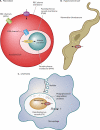Nutrient transport and pathogenesis in selected parasitic protozoa
- PMID: 21216940
- PMCID: PMC3127635
- DOI: 10.1128/EC.00287-10
Nutrient transport and pathogenesis in selected parasitic protozoa
Abstract
Parasitic protozoa, such as malaria parasites, trypanosomes, and Leishmania, acquire a plethora of nutrients from their hosts, employing transport proteins located in the plasma membrane of the parasite. Application of molecular genetic approaches and the completion of genome projects have allowed the identification and functional characterization of a cohort of transporters and their genes in these parasites. This review focuses on a subset of these permeases that have been studied in some detail, that import critical nutrients, and that provide examples of approaches being undertaken broadly with these and other parasite transporters. Permeases reviewed include those for hexoses, purines, iron, polyamines, carboxylates, and amino acids. Topics of special emphasis include structure-function approaches, critical roles for transporters in parasite viability and physiology, regulation of transporter expression, and subcellular targeting. Investigations of parasite transporters impact a broad spectrum of basic biological problems in these protozoa.
Figures

References
-
- Akerman M., Shaked-Mishan P., Mazareb S., Volpin H., Zilberstein D. 2004. Novel motifs in amino acid permease genes from Leishmania. Biochem. Biophys. Res. Commun. 325:353–366 - PubMed
-
- Arastu-Kapur S., Arendt C. S., Purnat T., Carter N. S., Ullman B. 2005. Second-site suppression of a nonfunctional mutation within the Leishmania donovani inosine-guanosine transporter. J. Biol. Chem. 280:2213–2219 - PubMed
-
- Arastu-Kapur S., Ford E., Ullman B., Carter N. S. 2003. Functional analysis of an inosine-guanosine transporter from Leishmania donovani: the role of conserved residues, aspartate 389 and arginine 393. J. Biol. Chem. 278:33327–33333 - PubMed
Publication types
MeSH terms
Substances
Grants and funding
LinkOut - more resources
Full Text Sources

